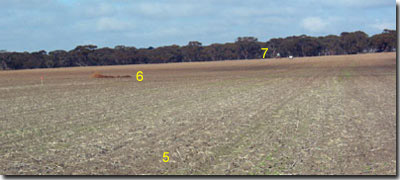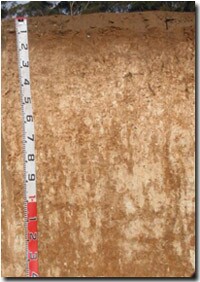ORZC7
| Location: Reedy Dam | Australian Soil Classification: Endohypersodic, Pedal, Hypercalcic CALCAROSOL |
| Geology: Quaternary (Woorinen Formation). | General Landscape Description: Upper slope of a low rise on a gently undulating plain. |
| Site Description: Ploughed cropping paddock. | Native Vegetation: Mallee. |
 Site ORZC7 Landscape |
Soil Profile Morphology:
Surface Soil
| Ap | 0-10 cm | Dark brown (10YR3/3); sandy clay loam; weak consistence (dry); very highly calcareous; soft surface condition; pH 8.5; abrupt change to: |  Site ORZC7 profile |
| Subsoil | |||
| B21 | 10-15 cm | Brown (7.5YR4/4 & 5/4); light clay (fine sandy); weak coarse blocky structure; firm consistence (dry); highly calcareous; pH 8.6; abrupt change to: | |
| B22k | 15-40 cm | Reddish yellow (7.5YR8/6); light medium clay (fine sandy); weak-moderate coarse to medium polyhedral structure; very many (>50%) fine earth carbonates and calcareous nodules; very firm consistence (dry); very highly calcareous; pH 9.4; gradual change to: | |
| B23k | 40-80 cm | Reddish yellow (7.5YR7/6); light medium clay; weak-moderate coarse to medium polyhedral structure; very many (>50%) fine earth carbonates; very firm consistence (dry); pH 10.1; gradual change to: | |
| B24 | 80-130 cm | Yellowish red (5YR6/6) and reddish yellow (5YR6/8); medium clay (sandy); moderate coarse to medium polyhedral structure; very many (>50%) fine earth carbonates; strong consistence (slightly moist); pH 10.0; diffuse change to: | |
| B25 | 130+ cm | Reddish yellow (5YR6/8 & 6/6) with few (2%) light pinkish brown (7.5YR7/4) and light grey (10YR7/2) mottles; medium clay (sandy); weakly structured; manganese flecks; moderately calcareous; pH 10.1. | |
Key Profile Features:
- High amounts of calcium carbonate (lime) throughout the subsoil.
- Gradual increase in clay content with depth.
pH | Salinity Rating | |||
Surface Soil (0-10 cm) | Moderately Alkaline | Low | Non-Sodic | None |
Upper subsoil (10-15 cm) | Moderately Alkaline | Low | Non-Sodic | None |
Deeper subsoil (at 40-80 cm) | Extremely Alkaline | Low | Strongly Sodic | Strong |
Deeper subsoil (at 130 cm) | Extremely Alkaline | Low | Strongly Sodic | Strong |
 |
Horizon | Horizon Depth (cm) | pH (water) | pH (CaCl2) | EC 1:5 | NaCl % | Boron mg/kg | Exchangeable Cations | Field Capacity pF 2.5 | Wilting Point pF 4.2 | Coarse Sand (0.2-2 mm) | Fine Sand (0.02-0.2 mm) | Silt (0.002-0.02 mm) | Clay (<0.002 mm) | |||
Ca | Mg | K | Na | |||||||||||||
meq/100g | ||||||||||||||||
Ap | 0-10 | 8.5 | 8.0 | 0.18 | 2.7 | 27 | 2.8 | 1.6 | 0.37 | 18 | 10 | 38 | 27 | 9 | 17 | |
B21 | 10-15 | 8.6 | 8.0 | 0.24 | 2.6 | 29 | 4.2 | 1.1 | 0.44 | 20 | 11 | 36 | 22 | 4 | 21 | |
B22 | 15-40 | 9.4 | 8.3 | 0.21 | 3.5 | 24 | 6.6 | 0.88 | 2.3 | 27 | -- | 30 | 16 | 2 | 24 | |
B23k | 40-80 | 10.1 | 8.9 | 0.60 | <0.01 | 31 | 1.8 | 6.4 | 1.3 | 6.9 | 34 | 17 | 22 | 18 | 2 | 29 |
B24 | 80-130 | 10.0 | 8.8 | 0.59 | 0.01 | 31 | 1.2 | 4.4 | 1.1 | 6.5 | 30 | 13 | 24 | 21 | 4 | 20 |
B25 | 130+ | 10.1 | 9.6 | 0.61 | 0.01 | 27 | 1.0 | 4.8 | 1.4 | 7.7 | ||||||
Management Considerations:
Whole Profile
- High levels of soil carbonates appear to retard or inhibit the breakdown of some agricultural chemicals. On neutral to acidic soils, these chemicals are usually deactivated during the season of application. Some herbicides can possibly persist for several seasons and may damage subsequent crops and pastures (Maschmedt, 2000).
- The surface soil is well suited as a seedbed – the surface condition is soft and the soil has a weak consistence (i.e. it does not become excessively hard). However, it is quite shallow and should be protected as much as possible from wind and water erosion and over-cultivation. Promoting organic matter levels would be beneficial.
- Most of the subsoil is extremely alkaline and has high amounts (> 50%) of visible calcium carbonate. This indicates that phosphorus and some trace elements such as iron, manganese, zinc and copper may be poorly available to plants and deficiencies may occur. Deficiencies can be determined by plant tissue analysis.
- Some species of plants are highly sensitive to calcareous soils. Lupins, for example, can perform poorly on soils with high carbonate levels within 30 cm of the surface. This could be due to extreme sensitivity to iron deficiency (White 1990).
- Boron toxicity can also occur in strongly alkaline soils. The boron levels measured in the deeper extremely alkaline subsoil (i.e. at 40 cm depth) are quite high at this pit site and may affect boron-sensitive species including cereals, pulses, pasture legumes. Concentrations as low as 10 ppm, for example, can reduce lentil yield. Although there is limited data it is estimated that the threshold level of soluble boron for cereals is 15 mg/kg (Cartwright et al., 1984). Other work at VIDA indicates that where there are low levels of soluble salts boron tolerance can be comparatively high, with little reduction in wheat yield at levels of up to 45 ppm (Quinlan, 2001).
- Most of the subsoil is strongly sodic and disperses strongly. This will result in restricted root and water movement into the subsoil. The large amounts of fine carbonates can also act to restrict drainage.
References:
Cartwright, B., Zarcinas, B.A, and Mayfield, A.H. (1984). Toxic concentrations of boron in a red-brown earth at Gladstone, South Australia. Australian Journal of Soil Research. 22. 261-72.
Hobson, K. (2001). Boron Tolerant Lentils. In On The Pulse pamphlet. NRE. 2001.
Maschmedt, D. (2000). Agricultural Land Classification Standards used in South Australia’s Land Resource Mapping Program. Department of Primary Industries South Australia.
Quinlan, J. (2001). Sorting out the Boron Problem. Wimmera Farming & Landcare Newsletter. 19-20.
Rengasamy, P. and Churchman, G.J. (1999). Cation Exchange Capacity, Exchangeable Cations and Sodicity. In: Soil Analysis – An Interpretation Manual. (eds. Peverill, K.I et al). CSIRO Publishing.
White, P.F. (1990). Soil and Plant Factors Relating to the Poor Growth of Lupinus species on Fine Textured Soils – A Review. Australian Journal of Agricultural Research 41: 871-890.


